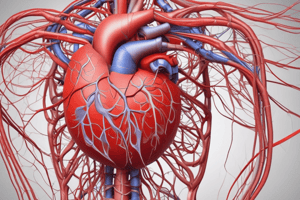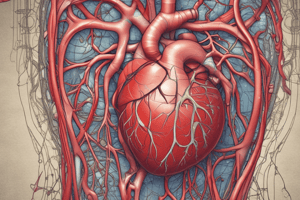Podcast
Questions and Answers
What is the primary function of arteries in the cardiovascular system?
What is the primary function of arteries in the cardiovascular system?
What characterizes muscular arteries compared to elastic arteries?
What characterizes muscular arteries compared to elastic arteries?
Which of the following best describes vasoconstriction?
Which of the following best describes vasoconstriction?
What is the largest artery in the body?
What is the largest artery in the body?
Signup and view all the answers
What is the primary role of the closed system of blood vessels in the cardiovascular system?
What is the primary role of the closed system of blood vessels in the cardiovascular system?
Signup and view all the answers
What is the primary role of arterioles in the circulatory system?
What is the primary role of arterioles in the circulatory system?
Signup and view all the answers
Which type of capillary is characterized by the presence of fenestrations?
Which type of capillary is characterized by the presence of fenestrations?
Signup and view all the answers
What effect does vasoconstriction of arterioles have on blood pressure?
What effect does vasoconstriction of arterioles have on blood pressure?
Signup and view all the answers
What is the term used for the process of supplying blood to tissues?
What is the term used for the process of supplying blood to tissues?
Signup and view all the answers
Which type of capillary is the least common in the body?
Which type of capillary is the least common in the body?
Signup and view all the answers
Study Notes
Cardiovascular System
- Plays a vital role in maintaining homeostasis by transporting blood and materials throughout the body.
- Blood vessels form a closed system that carries blood away from and back to the heart.
Arteries
- Function to carry blood away from the heart to organs.
- Two main types:
- Elastic Arteries: Largest diameter, including aorta and pulmonary trunk, characterized by thick walls and elasticity.
- Muscular Arteries: Medium-sized with more smooth muscle, capable of regulating blood flow through vasoconstriction and vasodilation.
Arterioles
- Microscopic vessels that regulate blood flow into capillary networks.
- Known as resistance vessels, they control blood pressure through their ability to constrict and relax.
Capillaries
- Smallest blood vessels, essential for the exchange of gases and nutrients.
- Main types:
- Continuous Capillaries: Most common, found in many tissues.
- Fenestrated Capillaries: Contain pores for increased permeability.
- Sinusoidal Capillaries: Least common, allow for larger materials to pass through.
Veins
- Convey blood from tissues back to the heart.
- Types of veins:
- Superficial Veins: Located within the subcutaneous layer.
- Deep Veins: Accompany arteries and are often found in pairs.
- Anastomotic Veins: Connect superficial veins with deep veins.
Cardiovascular Center
- Located in the medulla oblongata, regulates heart rate and stroke volume.
- Responds to input from three types of sensory receptors:
- Chemoreceptors: Monitor chemical concentrations in the blood.
- Proprioreceptors: Track movements of joints and muscles during activity.
- Baroreceptors: Detect changes in blood pressure and wall stretch in blood vessels.
Blood Circulation
- Pulmonary Circulation: Responsible for oxygen supply and carbon dioxide removal from the heart.
-
Systemic Circulation: Moves blood from the heart to the rest of the body and vice versa.
- Coronary Circulation: Supplies blood to the heart muscle.
- Cerebral Circulation: Delivers blood to the brain.
- Hepatic Portal Circulation: Extends from the gastrointestinal tract to the liver.
Venous Circulation
- Coronary Sinus: Receives blood from cardiac veins and drains heart tissue.
- Superior Vena Cava: Drains blood from regions superior to the diaphragm.
- Inferior Vena Cava: Drains blood from regions inferior to the diaphragm.
Aortic Circulation
- Ascending Aorta: Emerges from the left ventricle.
- Arch of Aorta: Bends to supply blood to upper body.
- Thoracic Aorta: Descends through the thorax.
- Abdominal Aorta: Divides into common iliac arteries at the lower abdomen.
Site Selection for Venipuncture
- Choosing the right venipuncture site is crucial for successful blood sampling.
Studying That Suits You
Use AI to generate personalized quizzes and flashcards to suit your learning preferences.
Description
This quiz focuses on the role of the cardiovascular system in maintaining homeostasis and its interaction with other body systems. Participants will learn about the various structures involved in transporting blood and distributing essential materials throughout the body. Test your knowledge on how the cardiovascular system contributes to overall health!





